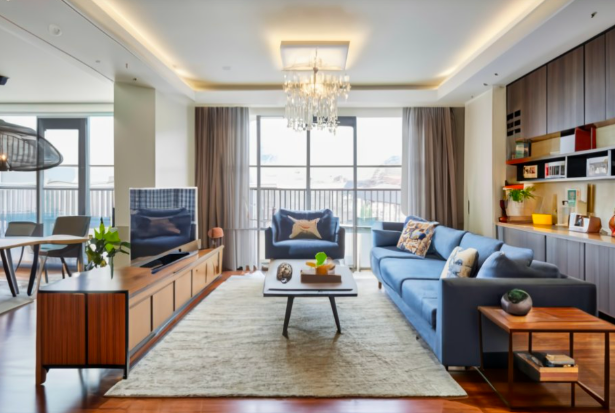The living room: a haven for relaxation, entertainment, and creating memories with loved ones. But an empty space doesn’t translate to a warm and inviting living room. This is where color comes in, playing a pivotal role in setting the mood, defining the space, and reflecting your unique personality. Choosing the right color scheme for your living room can be both exciting and daunting. This comprehensive guide delves into the world of color schemes, empowering you to create a harmonious and stylish living space that reflects your taste.
The Science Behind the Palette: Understanding Color Theory
Before diving into specific color schemes, understanding the basic principles of color theory is crucial. It’s the language through which colors communicate and interact with each other.
A. The Primary Colors:
The foundation of color theory lies in the three primary colors: red, yellow, and blue. These colors cannot be created by mixing other colors, but when combined in various proportions, they create a vast spectrum of new hues.
B. Secondary Colors:
Mixing primary colors in equal parts results in secondary colors: orange (red + yellow), green (blue + yellow), and violet (red + blue). These secondary colors, along with the primaries, form the six basic colors.
C. Tertiary Colors:
Further mixing primary and secondary colors creates tertiary colors, offering an even wider range of hues. Think of these as variations of the secondary colors, with a stronger influence from one of the primary colors used in the mix.
A Symphony of Colors: Popular Living Room Color Schemes
Now that you’re armed with the basics of color theory, let’s explore some popular color schemes to inspire your living room design:
A. Monochromatic Magic:
This scheme utilizes variations of a single color to create a serene and sophisticated atmosphere. Play with shades, tints (lighter tones), and tones (darker tones) of your chosen color to add depth and dimension. This approach works well for small living rooms as it creates a sense of spaciousness.
B. Analogous Harmony:
Analogous colors sit next to each other on the color wheel. Choosing two or three analogous colors, like blue, blue-green, and green, creates a calming and harmonious effect. This scheme is a safe bet for beginners and offers a cohesive and pleasing aesthetic.
C. Complementary Contrast:
Complementary colors sit directly opposite each other on the color wheel. Think red and green, blue and orange. This bold approach creates a vibrant and dynamic atmosphere. However, use complementary colors sparingly to avoid an overwhelming effect. Consider using one color as the dominant element and the other as an accent.
D. Triadic Power:
For a more adventurous approach, explore the triadic color scheme. This involves using three colors evenly spaced on the color wheel, like red, yellow, and blue. This scheme creates a lively and energetic space. To achieve balance, use one color as the main focus and the other two as accents.
Finding Your Perfect Match: Considerations When Choosing a Color Scheme
Beyond aesthetics, several factors influence the success of your color schemes living room:
A. Room Size and Layout:
Lighter colors like white, beige, and pale pastels can make a small living room feel more spacious. For larger rooms, darker tones or bolder colors can create a more intimate setting. Consider the shape of your living room as well. Open floor plans may benefit from a unifying color scheme, while defined spaces can handle more variation.
B. Natural Light and Artificial Lighting:
The amount of natural light your living room receives significantly impacts the perceived color. North-facing rooms tend to have cooler light, while south-facing rooms receive warmer light. Consider using warmer colors in north-facing rooms to balance the cooler light and vice versa. Artificial lighting also plays a role. Warm lighting can further enhance warm colors, while cool lighting can help balance bold color choices.
C. Mood and Atmosphere:
What feeling do you want to evoke in your living room? Cool colors like blue and green create a calming and relaxing atmosphere, while warm colors like red and orange stimulate conversation and energy. Consider your desired mood and choose colors that reflect it.
Putting It All Together: Implementing Your Color Scheme
Now that you’ve chosen your color scheme, here’s how to bring it to life:
A. The Foundation: Wall Color
The wall color typically serves as the dominant element in your living room color scheme. Consider the size and layout of the room when choosing a wall color. Lighter colors can make a small space feel bigger, while darker colors can add drama and intimacy.
B. Furniture and Fabrics:
Furniture plays a significant role in establishing your color scheme. Sofas, armchairs, and ottomans are prime opportunities to incorporate your chosen colors. Opt for neutral-colored furniture if your walls are a bold statement piece. Conversely, patterned fabrics on furniture can add a touch of personality if your walls are a monochromatic color.
C. Accent Pieces:
Accent pieces like throw pillows, rugs, artwork, and decorative items allow you to introduce pops of color or complementary shades from your chosen scheme. This is where you can experiment with bolder patterns and textures to add visual interest and personality to your space.
Unveiling the Trends: What’s Hot in Living Room Color Schemes
The world of interior design is constantly evolving, and color trends offer exciting ways to breathe life into your living room. Here are some popular trends to consider:
A. Timeless Appeal of Neutral Tones:
Neutral colors like beige, gray, and white continue to be a popular choice for living rooms. They offer a versatile backdrop for a variety of furniture styles and décor elements. This foundation allows you to easily adjust the mood and style of your space through pops of color with accent pieces and artwork.
B. Bold and Vibrant Statements:
For the adventurous homeowner, bold and vibrant colors are making a comeback. Deep jewel tones like emerald green, sapphire blue, and amethyst purple can create a luxurious and sophisticated atmosphere. Accentuate these bold colors with neutral furniture and metallic finishes for a balanced and stylish look.
C. Nature-Inspired Hues:
Nature continues to be a significant source of inspiration for interior design. Earthy tones like sage green, terracotta, and sandy beige bring a sense of tranquility and connection to the outdoors. This trend is perfect for creating a calming and restorative living environment.
Creating Cohesion: Tips for a Harmonious Color Scheme
A. Harness the Power of the Color Wheel:
Use the color wheel as a guide to create a harmonious color scheme. Choose colors that sit next to each other (analogous), opposite each other (complementary), or in a triangular formation (triadic) for a balanced and pleasing aesthetic.
B. Consider Textures and Patterns:
Don’t limit yourself to just color! Textures and patterns add visual interest and depth to your living room. Mix and match smooth textures with rough ones, and incorporate patterned fabrics alongside solid colors to create a dynamic and engaging space.
C. Finding Balance with Warm and Cool Tones:
Understanding the temperature of colors is crucial for creating a harmonious space. Warm colors like red, orange, and yellow evoke energy and conversation. Cool colors like blue, green, and violet create a calming and serene atmosphere. Aim for a balance between warm and cool tones to achieve a comfortable and inviting living room.
Inspiration Through Examples: Case Studies in Color Schemes
A. Contemporary Living Room with a Neutral Color Scheme:
Imagine a light and airy living room featuring crisp white walls, a plush cream-colored sofa, and a woven jute rug that adds a touch of natural texture. Accentuate this neutral foundation with pops of color through throw pillows in shades of blue and green, echoing the calming hues found in a modern abstract artwork hanging above the sofa.
B. Eclectic Living Room with Bold Color Accents:
Envision a vibrant living room where a deep emerald green statement wall becomes the focal point. A charcoal gray sofa with geometric patterned cushions adds a touch of sophistication. Balance the boldness with a light wood coffee table and a light-colored area rug. Introduce pops of gold through metallic lampshades and picture frames for a touch of glamour.
The Final Brushstroke: Conclusion
Choosing the right color scheme for your living room is an exciting opportunity to express your personality and create a space that reflects your taste. By understanding the basics of color theory, exploring popular schemes, and considering the factors that influence your living space, you can create a harmonious and stylish haven. Remember, there are no hard and fast rules. Don’t be afraid to experiment, trust your instincts, and have fun with the process. With a little planning and creativity, you can transform your living room into a space that embodies warmth, comfort, and a touch of your unique style.
To create a harmonious and beautiful living space, partner with MRD. Our team of experts can help you choose the perfect color scheme for your living room, incorporating your personal style and preferences. Contact us today to schedule a consultation and start transforming your living room into a space that reflects your unique taste.



